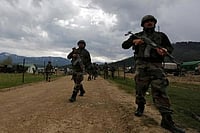The vertical drilling at Uttarakhand's Uttarkashi to rescue trapped workers in a collapsed tunnel has progressed up to 31 metres on Monday.
Even as vertical drilling is being conducted, the rescuers are also going ahead with manual horizontal drilling. Final 10-12 metres of the horizontal drilling would be carried out manually and specialised miners have arrived at the site for the purpose. The manual approach is being taken as the auger machine that had been drilling through the debris so far has broken down.
Earlier on November 12, a part of the under-construction Silkyara-Barkot tunnel in Uttarkashi caved in and trapped 41 workers. The tunnel is part of the Char Dham Project, which has been flagged over environmental concerns over the years, owing to the fragility of the Himalayan geology. The workers are trapped inside a 2-km stretch of under-construction tunnel. They have access to water and the area is well-lit as electricity connections were not snapped when the incident happened. Through pipes, they have also been provided with food and oxygen is also being pumped in there. They also have access to water.
While manual horizontal and vertical digging is taking place at Silkyara, horizontal drilling is also taking place at the other end of the tunnel at Barkot. The idea is that if none of the two approaches at Silkyara-end work, then the workers could be rescued by accessing them from the other side.
Here are the latest updates about the Uttarkashi rescue operation.
Vertical digging progresses up to 31 metres
The rescuers are conducting vertical digging from the top of the Silkyara tunnel. As per the latest updates, they have dug up to 31 metres out of the total 86 metres.
The idea is that once drilling is complete, pipes of 1.2-metre diameter would be inserted so the workers could be extracted.
While the digging to insert these larger pipes progresses, a smaller 200-mm diameter pipe has also been inserted up to 70 metres whose purpose is to learn about the nature of the soil and to see whether there is any obstacle in the way, said former engineer-in-chief and DG Border Roads Organisation Lt Gen Harpal Singh to reporters at the site.
'Rat miners' arrived for manual horizontal drilling
A team of miners has arrived at the Silkyara tunnel for manual horizontal drilling. Manual drilling is being conducted for the final stretch of 10-12 metres as the auger machine that did the bulk of the drilling has now broken down and any further mechanical drilling has been ruled out.
The purpose of horizontal drilling is to clear the debris enough to insert pipes through it to reach the workers. Once pipes are in place after the drilling is complete, then workers could crawl out of the tunnel through those pipes.
If no obstacle, such as metallic objects, are encountered in the manual drilling, then the process could be completed in 24 to 36 hours, according to Singh.
For the purpose of manual drilling, a team of six 'rat miners' has been brought to the site. This kind of mining refers to the situation when miners enter a confined space to perform their job. The PTI reported that a six-member rat-mining team has been brought to the site.
When asked whether going through the 800-mm diameter pipes would not be difficult for them, one of the team members said they had experience of manually clearing debris through even 600 mm diameter pipes, according to PTI, which added that the rat miners will go inside the pipes wearing a helmet, a uniform, a mask and glasses.
"Frames of 800 mm dia pipes have been prepared. We will move ahead by half a metre to one metre gradually. If all goes well and no obstacles are encountered a ten metre area can be covered in 24-36 hours," said Singh to PTI.
Though a time-consuming process, manual drilling seems a feasible option as only around 10-12 metres through the rubble remain to be drilled to complete the escape passage, noted PTI.
When asked which of these two options is likely to be completed first, Singh told reporters at the site that it is difficult to predict that as everything depends on whether or not any hurdles are encountered.
Robotic system to be deployed: Report
A private robotic system is also being deployed at the Uttarkashi tunnel to check mental health of the workers, provide them with internet access, and check for any accumulation of hazardous gases like methane in the tunnel, according to a report.
Robotics expert Milind Raj told ANI that he was called for assistance in the rescue operation by authorities engaged in the operation.
Raj said that his system was also used in a rescue operation in Lucknow.


























